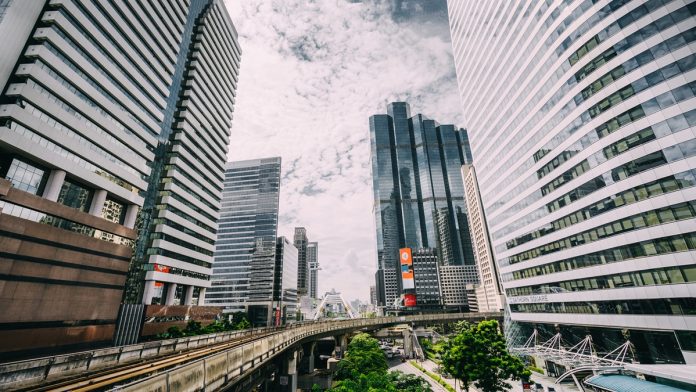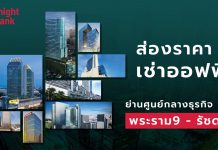Mr. Marcus Burtenshaw, Executive Director and Head of Occupier Services and Commercial Agency (OSCA), Knight Frank Thailand, said that “During the first quarter, almost everyone was working from home. However, as firms returned to the office during the second quarter, they began to take stock of their situation and review their options. For many, the strategic review process is still ongoing. Some firms are still uncertain about the outlook for their business, and what this economy will mean for their headcount projections and their subsequent demand for office space. During these reviews, many will also have to answer the question of whether or not working from home will be embraced going forward, and if so, to what degree?
This means that some elements of this quarter’s statistics may seem at times contradictory. We expected occupancies to fall as tenants started to return unused office space. But rising rents illustrates the illiquid nature of the market, and how the supply side does not react immediately to changes in demand. Looking ahead, if confidence in the economy falters, tenants will increasingly priortise cost control over quality, opting to reduce their footprint, or relocate to more competitively priced buildings. Couple this with more supply coming on stream, and tenants will find themselves with more choice, whilst landlords will face mounting downward pressure on rents.”
Office Property Market Indicators

Economic Overview
Thailand’s GDP contracted by 12.2% Y-o-Y in Q2 2020, deepening from the 2% fall in the previous quarter. This represents the steepest GDP contraction since the Asian financial crisis in 1998 during which a 12.5% contraction was recorded in Q2 1998.
The COVID-19 pandemic and the ensuing domestic and international measures to prevent and control the spread of the disease were major factors that contributed to the severe level of decline. While many restrictions were lifted towards the end of the 2nd quarter, the economic impacts were still clearly pronounced. Exports contracted by 28.3%, largely attributable to manufacturing products which were affected by temporary shutdowns and reduced global demand. Private final consumption dropped by 6.6% as spending on durable goods, semi-durables and services fell by 30.2%, 15.7% and 7%, respectively. The tourism sector remained largely diminished, as reflected by the 91.2% decline in expenditure of non-residents in the country as foreign tourist arrivals fell to zero. Meanwhile, an 8% drop in fixed capital formation can mostly be attributed to a 15% reduction in private investment. In contrast, government consumption expenditure and public investment expanded by 1.4% and 12.5%, respectively, as remedial measures to stabilize and restore the ailing Thai economy were rolled out.
Figure 1
Bangkok Office Supply

Supply
Based on Knight Frank Thailand Research, in Q2 2020, the total supply of office space in Bangkok increased by 99,420 sq m or 1.9% Q-o-Q to reach 5.33 million sq m. This was the first time supply increased by over 99,000 sq m since Q3 2011.Three new buildings were completed, adding 60,000 sq m to the CBD and 39,420 sq m to non- CBD areas. There were no withdrawals of obsolete stock. In comparison, supply grew at a rate of around 26,800 sq m per quarter over the past five years.
Table 1
Bangkok Office Future Supply

Table 2
Bangkok Office Future Supply (Projects)

Future Supply
Seven new projects are expected to be completed within the 2nd half of this year, which will add around 110,000 sq m of office space to the market. Around 47% or 52,423 sq m of projected new supply during this period will be located in the CBD.
Although two properties with a combined office space of 47,341 sq m projected to be completed in 2021 are experiencing minor delays, other buildings are still expected to be completed on schedule. If launches in Q3 through to 2023 proceed as planned, the Bangkok office market will grow by 1,216,139 sq m or an average of 347,468 sq m annually (accounting for only additions and not withdrawals). In comparison, from Q2 2016 to Q2 2019, new supply entered the market at a rate of around 185,000 sq m annually. From around 5.3 million sq m today, the total office market supply will likely reach 6.5 million sq m by the end of 2023.
Figure 2
Bangkok Office Annual Take Up

Figure 3
Bangkok Office Quarterly Supply – Demand Dynamics

Demand
Overall leasing activity fell as total take up declined by 11% from last quarter to 66,211 sq m. This level of take up is just slightly below the 10 year quarterly average of 67,126 sq m. Despite the relatively stable level of take up, a far greater amount of space was returned to the market as 115,750 sq m was vacated by tenants. This led to net absorption declining from 23,984 sq m to – 49,547 sq m, the lowest level recorded over the past 10 years. As a result, total occupied space dropped to 4.68 million sq m, representing a 1% quarterly decline. These factors indicate that although leasing activity is still ongoing, a significant portion of tenants have elected to reduce their real estate footprint as a cost saving measure. In addition, a number of companies may have shut down and exited the market entirely as the detrimental economic effects of the COVID-19 pandemic are prolonged.
Figure 4
Bangkok Office Supply Demand and Occupancy Rate

Due to an atypically large increase in supply and subdued demand, the market occupancy rate dropped by 2.6% points Q-o-Q and 3.5% points Y-o-Y to 87.7%. This is the 5th consecutive quarter drop in the occupancy rate, which puts the current level below the 10 year average of 89.9%.
When segmented by grade, it is apparent that higher grade properties were more affected by the market slowdown. While the occupancy rate declined across the board, it fell the most for the grade A segment, declining by 3.3% points Q-o-Q. Meanwhile, grades B and C experienced declines of 2.8% points and 1.6% points Q-o-Q, respectively. As the grade A occupancy level has fallen below its 10 year average, all segments underperformed their long term averages.
On a quarterly basis, occupancies are down across all sub-markets tracked, both in the CBD and non-CBD areas. The rate in both Asoke – Phrompong and Ploenchit – Chidlom fell by 3.5% points, the biggest decline amongst all sub-markets. In contrast, the rate declined the least in the Asoke – Petchburi area, falling by 0.7% points. Overall, the CBD and non-CBD areas experienced a relatively uniform level of decline, falling by 2.6% points and 2.7% points, respectively.
Figure 5
Bangkok Office Average Asking Rent by Grade

Rental Rates
Rents continued to face downward pressure underpinned by softening market conditions. The average asking rent increased by 0.4% Q-o-Q and 2.7% Y-o-Y to 798 baht per sq m per month. This level of growth is below the 4.2% average annual increase recorded over the past five years, although the values are starting to converge as limited rental growth is protracted.
Grade C properties experienced the highest quarterly rental increase, rising by 0.9% to reach 474 baht per sq m. Meanwhile, grade A rents increased by 0.5% to 1,137 baht. On the other hand, grade B rents stagnated after having undergone a negligible growth rate of 0.1% to 785 baht. However, rental growth across the various grades still remains consistent with recent trends whereby higher grade properties undergo more rental growth on an annual basis. Grade A rents are still up 5.4% Y-o-Y in contrast to grade C rents, which increased by 0.2% over the same period. Despite some quarterly fluctuations, in the face of office market conditions that continue to weaken, landlords of grade C properties will find it difficult to justify rental increases, especially since their competitive advantage lies in below-market rates.
Rents for properties in the CBD grew by more than those located outside of it. In the CBD, the average asking rent increased by 0.5% Q-o-Q and 3.5% Y-o-Y to 972 baht. For non-CBD areas, it rose by 0.2% Q-o-Q and 1.7% Y-o-Y to 642 baht.
Table 3
Bangkok Office Sub-Market Indicators

In the CBD, all areas sampled experienced negative quarterly rental growth with the exception of Asoke – Phrompong, where the average asking rent increased by 0.4%. On an annual basis, rents in all areas are still up except for those in Ploenchit – Chidlom where the asking rent fell by 0.1%. Outside the CBD, the average asking rent increased the most for Bangna, having risen by 1.7% Q-o-Q. This is also the highest growth rate recorded across all districts sampled. However, on an annual basis, the average asking rent in Bangna is down 2.4%, which is more than other sub-markets.
Figure 6
Bangkok Office Rental Cycle

Review and Outlook
Matching the projections we made at the end of Q1 2020, the Bangkok office property market continued to weaken with the negative impacts of COVID-19 becoming much more pronounced in the Q2 data. A greater number of firms are no longer waiting on the sidelines and have executed revised real estate strategies based on the current and projected impact of the pandemic on their business operations. While the past decade has been marked by a ‘flight to quality’, whereby tenants expanded their real estate footprint and invested in higher quality workspaces to attract talent and enhance productivity, there have been some signs of trend reversal in this quarter. A greater number of companies have decreased their real estate outlays either by surrendering some space back to the landlord, seeking sub-tenants or by relocating to a different property. Some have implemented working from home or remote working policies on a permanent basis. This is reflected by the large decline in net absorption despite a relatively stable level of take up. To reiterate, firms that opt to relocate generate demand for competitively priced buildings that can persist if these companies fail to recover to pre-crisis levels. Given that relocation itself is a costly capital expenditure, space reduction is likely to be the preferred option for most occupiers under financial constraints, unless they can find fitted out space that supports their operations at an attractive rate.
Prior to COVID-19, we already began to see signs of a weakening market given the mismatch in supply and demand levels. However, we believed that the flight to quality would continue to drive market growth as productivity and high quality workspace options increased. However, if the growing consensus that it will take 2 to 3 years for the Thai economy to recover to pre-crisis levels hold, the cost cutting approach to real estate that started to manifest may become a more prominent driver of leasing activity in the long term instead. Arguably, businesses in some sectors such as technology, e-commerce and healthcare have flourished in the face of COVID-19 and may increase their workspace requirements as their operations grow. However, businesses in such sectors are not likely to lease enough new space to offset those returned by businesses in severely impacted industries.
If supply continues to grow at its projected pace through to 2023 with little to no stock withdrawal and demand levels hold constant, then the market occupancy rate will continue to drop further. So far, there have not been any major delays or cancellations in future supply, but the minor delays to two projects due in 2021 suggest that there could be further disruptions to the pipeline if business conditions do not improve. Negative pressure on rental growth persisted in Q2. If vacancies continue to climb as companies seek cheaper buildings and adopt permanent remote working policies, then the downward pressure on rents will likely increase even further. In addition, as more high quality workspaces are added, the market will shift to become balanced or even tenant – favoured. Landlords will have to compete on both rent and non-monetary incentives to secure tenants, with heavier emphasis placed on incentives that prioritize health, safety and well-being.



















